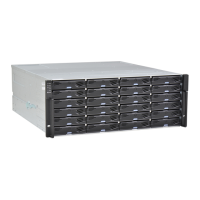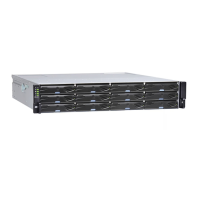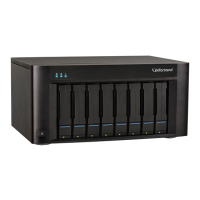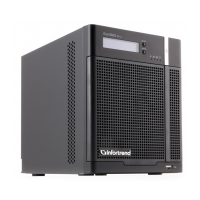2-18 Chapter 2: Hardware installation
2.3.2 Fibre-Host connections
The Fibre Channel standard allows optical connections. The optical cables are used over long distances
and have been proven to be more reliable. Due to the demands of high transfer rates, optical cables are
preferred for a 4 Gbps, 8 Gbps, or 16 Gbps ber connectivity and they are not vulnerable to EMI.
The bre host ports are connected to bre channel host adapters (HBA), that feature SFP interface with
full duplex transfer support in a PCIe interface. For the latest certied items, please contact the vendor
near you.
WARNING!
• All bre cables are sensitive and must be handled with care. To avoid interference, the cabling path
must be carefully planned without the cables getting bent.
• Lasers are hazardous and may cause blindness or permanent eye damage. Use them with utmost
caution. Never look directly when lasers are turned on or operating.
Detecting auto speed
Speed auto-detection is specied by the Fibre channel standard. If a 16 Gbps port is connected to an
8 Gbps port, the speed slows down at 8 Gbps. If there are 16 Gbps ports on both ends of the link, the
speed runs at 16 Gbps.
SFP/SFP+ transceivers
As SFP transceiver converts electrical data signals into light signals then transfers these signals
transparently via the optical ber. A transceiver provides bi-directional data links, a laser transmitter (for
ber optic cables), LC connector, and a metal enclosure to lower the EMI.
Other features of a typical SFP transceiver include a single power supply, low power dissipation, and
hot-swap capability. It is also important that the transceiver you use meets the FC performance and
reliability specications.
WARNING! The SFP transceiver has a laser diode featuring class 1 laser. To ensure safety, DO NOT
remove any covers or attempt access of the inside of the device. If problems arise or if you need
technical service, contact a qualied personnel.
FC port dust plugs
Each FC port comes with a dust plug. Remove these plugs ONLY when you insert an SFP transceiver.
NOTE: Contact your vendor for the list of compatible components.
Fibre-host topologies
The bre-host standard supports three topologies:
• Point-to-point topology
A direct connection between two bre-channel devices. The simplest among the three topologies.
• FB-AL (Fibre Channel Arbitrated Loop)
The bre-channel devices are all connected to a loop. Each device is assigned to an AL_PA
(Arbitrated Loop Physical Address). FC-AL supports 124 devices in a single loop. This is the most
commonly-used topology among the three.
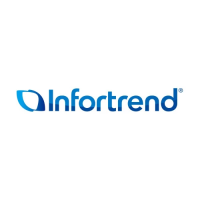
